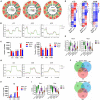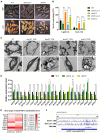Potential Role of Domains Rearranged Methyltransferase7 in Starch and Chlorophyll Metabolism to Regulate Leaf Senescence in Tomato
- PMID: 35211145
- PMCID: PMC8860812
- DOI: 10.3389/fpls.2022.836015
Potential Role of Domains Rearranged Methyltransferase7 in Starch and Chlorophyll Metabolism to Regulate Leaf Senescence in Tomato
Abstract
Deoxyribonucleic acid (DNA) methylation is an important epigenetic mark involved in diverse biological processes. Here, we report the critical function of tomato (Solanum lycopersicum) Domains Rearranged Methyltransferase7 (SlDRM7) in plant growth and development, especially in leaf interveinal chlorosis and senescence. Using a hairpin RNA-mediated RNA interference (RNAi), we generated SlDRM7-RNAi lines and observed pleiotropic developmental defects including small and interveinal chlorosis leaves. Combined analyses of whole genome bisulfite sequence (WGBS) and RNA-seq revealed that silencing of SlDRM7 caused alterations in both methylation levels and transcript levels of 289 genes, which are involved in chlorophyll synthesis, photosynthesis, and starch degradation. Furthermore, the photosynthetic capacity decreased in SlDRM7-RNAi lines, consistent with the reduced chlorophyll content and repression of genes involved in chlorophyll biosynthesis, photosystem, and photosynthesis. In contrast, starch granules were highly accumulated in chloroplasts of SlDRM7-RNAi lines and associated with lowered expression of genes in the starch degradation pathway. In addition, SlDRM7 was activated by aging- and dark-induced senescence. Collectively, these results demonstrate that SlDRM7 acts as an epi-regulator to modulate the expression of genes related to starch and chlorophyll metabolism, thereby affecting leaf chlorosis and senescence in tomatoes.
Keywords: DNA methylation; SlDRM7; chlorophyll metabolism; leaf chlorosis and senescence; starch excess.
Copyright © 2022 Wen, Wang, Zhu, Han, Huang, Huang, Hong, Zheng, Yang and Chen.
Conflict of interest statement
The authors declare that the research was conducted in the absence of any commercial or financial relationships that could be construed as a potential conflict of interest.
Figures








Similar articles
-
Suppression of a hexokinase gene, SlHXK1, leads to accelerated leaf senescence and stunted plant growth in tomato.Plant Sci. 2020 Sep;298:110544. doi: 10.1016/j.plantsci.2020.110544. Epub 2020 Jun 4. Plant Sci. 2020. PMID: 32771157
-
SlMYC2 mediates jasmonate-induced tomato leaf senescence by promoting chlorophyll degradation and repressing carbon fixation.Plant Physiol Biochem. 2022 Jun 1;180:27-34. doi: 10.1016/j.plaphy.2022.03.026. Epub 2022 Mar 30. Plant Physiol Biochem. 2022. PMID: 35378389
-
Melatonin delays dark-induced leaf senescence by inducing miR171b expression in tomato.J Pineal Res. 2022 Apr;72(3):e12792. doi: 10.1111/jpi.12792. J Pineal Res. 2022. PMID: 35174545
-
Overexpression of SlOFP20 in Tomato Affects Plant Growth, Chlorophyll Accumulation, and Leaf Senescence.Front Plant Sci. 2019 Nov 29;10:1510. doi: 10.3389/fpls.2019.01510. eCollection 2019. Front Plant Sci. 2019. PMID: 31850017 Free PMC article.
-
Leaf Senescence by Magnesium Deficiency.Plants (Basel). 2015 Dec 11;4(4):756-72. doi: 10.3390/plants4040756. Plants (Basel). 2015. PMID: 27135350 Free PMC article. Review.
Cited by
-
Epigenetic control of plant senescence and cell death and its application in crop improvement.Front Plant Sci. 2023 Oct 30;14:1258487. doi: 10.3389/fpls.2023.1258487. eCollection 2023. Front Plant Sci. 2023. PMID: 37965008 Free PMC article. Review.
-
Recent Advances in Studying the Regulation of Fruit Ripening in Tomato Using Genetic Engineering Approaches.Int J Mol Sci. 2024 Jan 7;25(2):760. doi: 10.3390/ijms25020760. Int J Mol Sci. 2024. PMID: 38255834 Free PMC article. Review.
References
LinkOut - more resources
Full Text Sources

